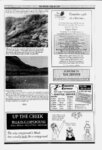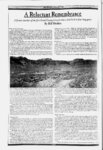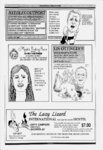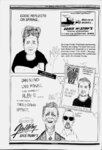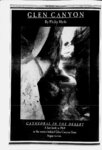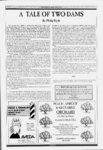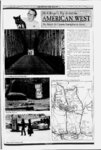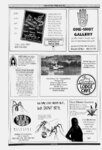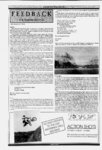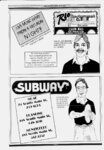| OCR Text |
Show WHY WE SHOULD DRAIN LAKE POWELL (continued) Club, fighting to save the preferred dam site at Echo Park on the Green River in Dinosaur National Monument; insisted that Glen Canyon would make a much better site for the high dam and would not oppose such a plan, if only BuRec would leave Echo Park alone. Never before had citizens from across the country become so involved in an environmental issue like this. Thousands of anti- - Echo Park Dam telegrams and letters, from Maine to California, flooded the Congress. Finally, against all odds, BuRec backed down. They could get along without their Green River dam after all; they could live with a high dam at Glen Canyon. Then "the winners" went down to Utah to see what they had compromised away. They could not believe their eyes. And it broke their hearts. What had protected Glen Canyon for so many years, its isolation, had now doomed it to a watery grave. None, not one of the defenders of Echo Park, had ever seen Glen Canyon. And now it was too late. An act of Congress, the Colorado River Storage Project, was signed into law by President Eisenhower on April 11, 1956. Within six months, construction of roads and a new bridge at the dam site and preliminary work on the dam itself had begun. There was no going back. Glen Canyon Dam would be built. of this the dam has completely altered the it run on down to the Gulf of California. On top where fish are now reappearing in the river below the dam. silting problem to the point roda a horse and flown over tha canyon before the dam was Having walked, rowed a boat, there I think we came out better than ever on the trade." But by 1986, as Goldwater prepared to retire from the Senate, his feelings had one vote in his entire Senate career, it would have been changed. If he could re-ca- st the vote that doomed Glen Canyon. In twelve years, apparently, the memory of that he hadn't expected. place had come back to him in ways At Glen Canyon Recreation Area, it's difficult continues. And the shift in sentiment to find a park ranger who will defend the reservoir (unless she is speaking "on the record" of course...those poor rangers: when will they find their voice?) time to ask: "What's under the lake?" Simply, no one...nobody who ever takes the and then sees the pictures and hears the stories, ever feels quite the same again. Ever sense of personal loss. escapes the melancholy sadness and the If they don't, they're not really alive A Lousy Place to Build a Dam From the time men first started thinking about "taming" the Colorado River, it was tough to find an engineer who was enthusiastic about a dam in Glen Canyon. Its appeal was limited. Certainly building a storage dam upriver would make lower Colorado dam projects easier. But Glen Canyon was in the middle of nowhere. To tap its electrical generating potential, power lines would have to be built across hundreds of miles of empty desert, to carry the power to the cities that needed them. The reservoir site, in the hot, arid Four Comers region, was sure to lose untold amounts of water through evaporation. Some scientists even believed that vast underground basins beneath the Kaiparowits Plateau would siphon off as much as 350 million acre feet of water and that 15 million gallons of water a day would flow around the abutments of any dam built in the porous Navajo sandstone. This, at least, never happened. But all the experts agreed the dam offered one irrefutable advantage it would certainly extend the life of the downstream Lake Mead, the reservoir formed by the construction of Hoover Dam in the 1930s. The Colorado River (Spanish translation: red color of the flowing water. Each spring river), got its name from the rich brown-re- d the Colorado carried millions of tons of silt and sediment through its canyons to the Gulf of California. Hoover Dam not only impeded the flow of the river, it stopped dead in its muddy tracks, the sediments that came with it. And so, dire were doomed made the about reservoir and the time it would take predictions already for all that silt to fill Lake Mead. Incredibly, proponents of the Glen Canyon Project liked to brag that one of the side benefits of their dam was the fact that its construction would dramatically extend the predicted lifetime of Lake Mead. All that silt would now be stopped by Glen Canyon Dam. Good thinking. Save one reservoir by silting in another. Early estimates by BuRec predicted the annual accumulation of sediment in Lake Pbwell at 85,400 acre feet. At that rate, the lake would fill with mud in 316 years. But in 1976, another study funded by the National Science Foundation, calculated an annual silt accumulation of only 27,000 acre feet. At that reduced rate, the lake might not fill for a thousand years. The fact is, no one knows. I do know, that four years ago, when the waters of Lake Pbwell reached a 15 year low, the mud flats near Hite made travel up Narrow Canyon by motorized craft nearly impossible. And inevitably, whether it happens in 200 years or 300 years or in a thousand years, all blinks of the eye in geologic time, the reservoir will silt up completely and a meandering river will make its way to the seven hundred foot waterfall formerly called Glen Canyon Dam. The huge concrete plug's sole purpose will by then be to keep 27 million acre feet of mud from washing downstream. semi-dissolv- ed The Dam Dream begins to crack There were always those who hated the dam. Ken Sleight. Phil Hyde. Eliot Pbrter. Katie Lee. Kent Frost. Bus Hatch. A1 Quist. Ed Abbey. There were others, many others, of course, who floated the river before the dam was even a project to be seriously considered (and feared). And more that came after construction began, including David Brower, who was devastated. In the thirty four years that have passed since Lake Powell began to rise behind the dam, thousands of people, tens of thousands, who never even saw Glen Canyon have added their voices and their anger to the once lonely chorus of dam haters. But the chorus now includes some surprises. The Udall brothers, Morris and Stewart, one an Arizona congressman and the other Kennedy's Secretary of the Interior, were both enthusiastic supporters of Glen Canyon Dam. In fact, they both advocated even more dramatic and controversial plans to construct dams in the Grand Canyon, ideas that both faltered and failed as public support dwindled in the late 1960s. Now, both Udall brothers question their earlier unrestrained dam building glee. And Barry Goldwater. Mr. Conservative. In 1974, as I was just warming to the role of Second Generation Glen Canyon Dam Hater, I sent the senator a letter. How could a man like himself, I asked, who so genuinely loved the canyons and rivers of the Colorado Plateau, have supported such an abomination as Glen Canyon Dam. Several weeks later he wrote back and, in part said: 1 supported the original concept (of Glen Canyon Dam) and still support it today. Regarding water storage, even with evaporation, we are saving more than by just letting k 2"- - W -- TTr-i- f . k t "" uiiwjjp ;L ' ft . . . We could put Glen Canyon back on the map again. And now? DRAIN THE LAKE. Last October, I picked up my morning copy of The Salt Lake Tribune and there, in 30 point type, the headline read, "Sierra Club: Let's Drain Lake Powell." It was David Brower, on the dam warpath again. Speaking at Kingsbury Hall, he had come to promote the idea that "environmentally and economically," the time had come to drain Lake Powell. It was time to quit lamenting the loss of Lake Powell; it was time to fix it. And he had some powerful facts to defend his proposal. Most notably, the Bureau of Reclamation recently released an interesting Lake Pbwell statistic. The bureau calculated that there is significantly less water that leaves the reservoir at Glen Canyon Dam than enters it at its headwaters north of Hite. In fact, a million acre feet of water is disappearing every year. They've determined that more than 600,000 acre feet is evaporating from the massive lake surface, something that was predicted 40 years ago. Where the other 400,000 acre feet is disappearing to is not completely known, but it is assumed that much of it is being absorbed into the porous Navajo sandstone, a phenomenon called bank storage. Again, scientists saw all this coming in the 50s, when many of them aigued that Glen Canyon was a lousy place to build a dam. What is most significant about the BuRec data is the fact that, as the U.S. population continues to grow, water becomes a scarcer, and thus more precious resource. According to Brower, a million acre feet of water could meet the domestic needs of 4 million people. In Salt Lake City that amount of water carries a value of $435 million. In Brower' s home town of Berkeley, California, it's worth more than a billion bucks. At some point in the future, water may be worth a lot more than the kilowatt hours the dam's turbines generate or the tourist dollars it adds to the local economies. It might someday be worth its weight in gold. A month later, the national board of the Sierra Club voted unanimously to support Brower's idea: DRAIN LAKE POWELL. And the idea caught on. On December 20, Dave Wegner, former head of the Glen Environmental Studies Canyon Group, endorsed Brower's proposal. Wegner had earlier resigned from the Bureau of Reclamation, saying that efforts to restore the river downstream from Glen Canyon Dam was more a government publicity stunt than anything else. Now, free from the chains of his former employer, the federal SIXTEEN it ft 4- I i ' |




